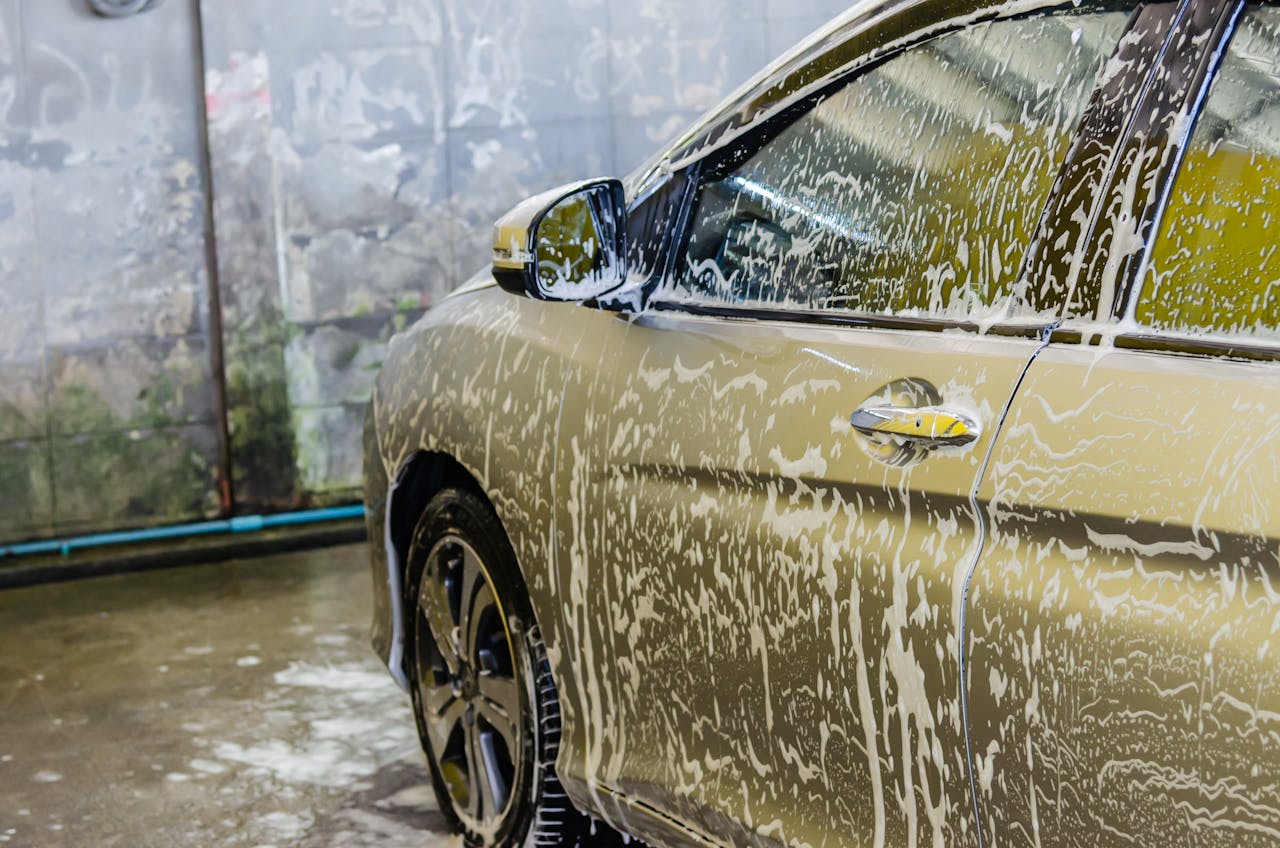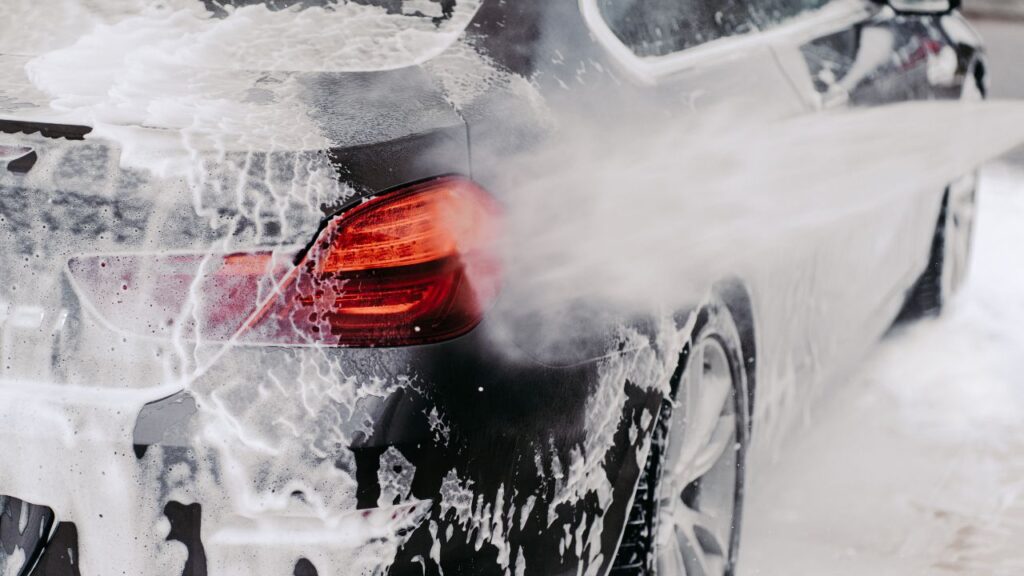Water spots on your car can be frustrating and unsightly. These spots, which are caused by the minerals in water drying on the surface of your vehicle, can leave behind residue that dulls the paint and can even become etched into the clear coat if left untreated. Whether they appear after a car wash or a rainstorm, learning how to effectively get rid of water spots on your car is essential for keeping your vehicle looking its best.
In this guide, we’ll explore what water spots are, why they form, and provide several methods to get rid of water spots on car surfaces, so you can restore your vehicle’s shine and protect the paintwork.
What Causes Water Spots on Cars?
Water spots form when water droplets dry on the surface of your car, leaving behind the minerals, such as calcium and magnesium, contained in the water. These minerals can etch into the clear coat or paint over time, causing more permanent damage.
Water spots are especially common in areas with hard water, which contains higher levels of minerals, but can occur after rain, sprinklers, or car washes if the water isn’t dried off properly.
There are two primary types of water spots:
- Mineral Deposits (Regular Water Spots): These are the most common water spots caused by minerals left behind when the water evaporates.
- Etched Water Spots: Over time, if not removed, water spots can etch into your car’s clear coat or paint. These are more challenging to remove and may require more aggressive treatment.
How to Prevent Water Spots on Your Car

Before diving into how to get rid of water spots on car surfaces, let’s first touch on prevention. By taking a few simple steps, you can reduce the occurrence of water spots and minimize the need for extensive cleaning.
- Dry Your Car Immediately: After washing or driving in the rain, make sure to dry your car thoroughly using a clean, soft microfiber towel. This prevents water from evaporating on the surface and leaving spots behind.
- Avoid Washing in Direct Sunlight: Washing your car in direct sunlight can cause water to evaporate quickly, leading to more water spots. Try to wash your car in the shade or early in the morning.
- Use Filtered or Deionized Water: If you live in an area with hard water, using a water filter or deionized water for rinsing your car can help prevent mineral deposits from forming.
- Apply a Protective Wax or Sealant: A layer of wax or paint sealant helps protect your car’s surface and makes it easier to remove water spots if they do occur.
Now that you know how to prevent water spots, let’s get into how to get rid of water spots on car surfaces that are already affected.
1. Quick Method: Water and Vinegar Solution
For fresh or mild water spots that haven’t yet etched into the clear coat, a simple mixture of water and vinegar can be highly effective. Vinegar helps to break down the mineral deposits without damaging your car’s paint.
Steps:
- Mix equal parts distilled white vinegar and distilled water in a spray bottle.
- Spray the solution onto the affected areas of your car.
- Allow it to sit for a minute or two to break down the minerals.
- Gently wipe away the solution with a microfiber towel.
- Rinse the area with clean water and dry it thoroughly to prevent further spots.
This method works well for regular water spots but may not be effective for etched spots. For those, you’ll need a more robust approach.
2. Clay Bar Treatment
A clay bar is an excellent tool for removing contaminants from your car’s surface, including water spots. The clay bar works by gently lifting off the mineral deposits without damaging the paint. It’s a highly recommended method to get rid of water spots on car surfaces, especially if they’ve been left for a while.
Steps:
- Wash your car thoroughly to remove any dirt and debris.
- Apply a clay lubricant to the affected area.
- Gently rub the clay bar over the water spots in a back-and-forth motion.
- Continue until the water spots are no longer visible.
- Wipe the area with a clean microfiber towel and inspect the surface.
- Finish by applying a wax or sealant to protect the paint.
Using a clay bar can not only remove water spots but also enhance the smoothness of your car’s paint, giving it a freshly detailed finish.
3. Commercial Water Spot Remover Products
There are various products specifically designed to get rid of water spots on car surfaces. These commercial products contain chemicals that break down mineral deposits without harming the paint or clear coat.
Steps:
- Choose a reputable water spot remover product.
- Follow the manufacturer’s instructions on how to apply the product.
- Typically, you’ll apply the product to a microfiber towel and rub it onto the affected area.
- After a few minutes, wipe away the residue with a clean towel.
- Rinse the area with clean water and dry thoroughly.
Commercial water spot removers are often the quickest solution for stubborn water spots and are easy to find at auto parts stores or online.
4. Polishing and Buffing
For severe or etched water spots, simple cleaning methods may not suffice. In such cases, polishing or buffing the surface is necessary to remove the top layer of the clear coat where the spots have etched in. This method should be done with care, as improper polishing can damage the paint.
Steps:
- Wash and dry the car to remove any surface dirt.
- Apply a small amount of polishing compound to the affected area.
- Using a foam applicator or a polishing machine, work the compound into the surface in circular motions.
- Continue until the water spots are no longer visible.
- Wipe away any excess polish with a microfiber towel.
- Finish by applying a wax or sealant to protect the surface.
Polishing is one of the more advanced ways to get rid of water spots on car surfaces, and it’s best used for deep-set or etched spots that won’t come off with regular cleaning.
5. Detailing Professionals
If you’ve tried multiple methods and still can’t remove the water spots, it may be time to seek help from a professional detailing service. Professional detailers have access to specialized tools and products that can effectively remove water spots and restore your car’s finish.
A professional detailer will assess the severity of the spots and choose the best treatment, whether that’s a chemical cleaner, a clay bar, or machine polishing. While this option may be more expensive, it’s often the most reliable way to get rid of water spots on car surfaces, especially if they’ve caused significant damage.
Protecting Your Car After Water Spot Removal

Once you’ve successfully removed the water spots, it’s important to protect your car’s paint to prevent future spotting. Here are a few steps you can take to maintain the cleanliness and shine of your vehicle:
- Apply a Layer of Wax or Sealant: After cleaning, apply a layer of high-quality wax or paint sealant to your car’s surface. This will not only make the paint look shiny but also provide a protective barrier against water spots and other contaminants.
- Regular Car Washes: Washing your car regularly helps prevent the build-up of dirt, minerals, and other residues that can lead to water spots. Be sure to dry your car thoroughly after each wash.
- Park in Covered Areas: Parking your car under cover or in a garage can help prevent exposure to rain, sprinkler systems, and other water sources that can cause spots.
Conclusion
Water spots on your car can be more than just a cosmetic nuisance—they can cause long-term damage if left untreated. Fortunately, there are many effective ways to get rid of water spots on car surfaces, from simple home remedies like vinegar and water to professional-level treatments like polishing and clay bar applications.
By regularly maintaining your vehicle and addressing water spots promptly, you can keep your car looking its best for years to come.
Remember, prevention is key, so always take steps to dry your car properly and protect the paint with wax or sealants to avoid future water spots.




Pingback: How to Remove Cigarette Smell from Your Car: A Comprehensive Guide Car Wrap Insights